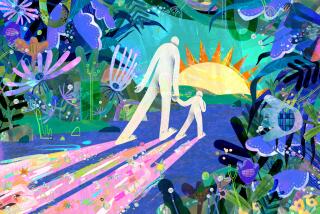Drunk on life: Yippee! with a wahoo! chaser
- Share via
ReMEMBER Tigger, the warm, impulsive, gregarious, irrepressible creature, the “Very Bouncy Animal” whose high spirits discombobulate the other inhabitants of Winnie the Pooh’s Hundred Acre Wood? Toad of “The Wind and the Willows” is similarly charming, “a whirligig of energy and contradictions: self-absorbed, yet generous; self-satisfied, yet quick to contrition; restless, yet oddly content
Kay Redfield Jamison brilliantly conjures up these characters to explore an emotion in “Exuberance: The Passion for Life.” Even in these children’s tales, however, A.A. Milne and Kenneth Grahame remind us of the ambivalent valence of exuberance, its creative, exciting elements easily toppling over into destruction and catastrophe. As adults, when we encounter the human counterparts of Tigger and Toad, we are every bit as inclined as their animal friends to see them as stimulating, but also as more than faintly alarming. We know that the effervescent becomes the manic, the pyrotechnics the pathological. Worse still, lurking in the background of the extravagant good feelings and the positive energy associated with exuberance are their polar opposites: Delirious joy is stalked by profound sadness; life-affirming enthusiasm by lifeless melancholy or, at its worst, by self-extinction. Jamison, afflicted with what fellow professionals label bipolar or manic-depressive disorder, is all too aware of how, paradoxically, the most energetic and ebullient may find themselves reduced to apathy and despair.
Curiously, there is an enormous literature on depression and suicide, commencing with Robert Burton’s classic “Anatomy of Melancholy,” which first appeared in 1621, but a comparatively sparse array of essays on positive emotions. Melancholy is, Burton assured his readers, “an inbred malady in every one of us,” and writers and publishers have since dissected the disease without surcease. It is about time someone examined the nature and significance of elated mood states.
Jamison, a professor of psychiatry at Johns Hopkins University’s School of Medicine, ranges widely over her chosen territory, offering a kaleidoscope of exemplars: writers and explorers, scientists and politicians, naturalists and even primates and other animals. Like Burton, she is addicted to profuse quotation, in her case not just from written sources but from interviews with a sizable number of exuberant individuals. At times, this approach grows wearisome and heavy-handed. For the most part, however, the sheer diversity of the figures examined amply suffices to retain the reader’s attention.
John Muir’s communion with nature, his unquenchable enthusiasm for its wonders, is set alongside that of Teddy Roosevelt, whose passions fueled his actions (and vice versa) until the death of his son in the mindless slaughter of World War I finally crushed his seemingly boundless appetite for life. Jamison shares the reverence both men had for the awe-inspiring qualities of the natural world, and she celebrates the infectious enthusiasm with which they attacked life.
She also examines field biologists, who passionately spend endless hours observing elephants or chimpanzees, their patience rewarded with sights that produce bursts of enthusiasm and make the wait worthwhile. Her secondhand descriptions of monkeys, lions and elephants at play are full of anthropomorphic commentary on their varying temperaments and emotional states. This leads her to an oft-repeated theme: the biological roots and possible evolutionary effects of such feelings and behaviors. Her enthusiasm threatens to run ahead of the evidence, but she makes a powerful case that exuberance “is incomparably more important than we acknowledge.”
Passion, delight, energy and enthusiasm, in Jamison’s view, fuel an optimistic approach to life, prompt risk-taking, encourage exploration and experimentation (both physical and intellectual) and infect others, thus multiplying the impact of a single exuberant individual. Though destructive in excess, infectious enthusiasm is mostly “a bounty and a blessing,” she writes, and with some success she examines the “role of moods in the creative process” in the arts and sciences.
Jamison’s most telling examples are drawn from science. The late physicist Richard Feynman of Caltech was, as Rabbit said of Tigger, the sort “who was always in front when you were showing him anywhere.” Feynman’s boundless curiosity and enthusiasm were legendary, as was his remarkable capacity for holding an audience in rapt attention, though the sheer force of his personality could overwhelm and intimidate his students. James Watson and Francis Crick, two bumptious young men who revolutionized the life sciences with their discovery of the “double helix,” the structure of DNA, were exuberant, heedless, competitive, arrogant and (particularly Watson) tactless.
Here, and in interviews with other prominent biologists, she shows not that exuberance is somehow essential to doing good science, for such is clearly not the case, but that exuberance plays a critical role in how scientists think about and actually do their work. Only exuberance, she suggests, enabled clinician and virologist Robert Gallo to survive the controversy and ensuing pressures over whether he or French scientists were first to isolate the HIV virus.
Other all-but-intolerable pressures can confront wartime political leaders. Winston Churchill was famous for his bouts with the “black dog” of depression, but it was his exuberance that transmitted itself to a nation and sustained both through the dark days of World War II. Churchill’s labile emotional life, Jamison writes, is a reminder of the mutability of moods: “They swing into and out of one another, for joy and grief inhabit close and traversable lands.” Here, without question, is the voice of experience, a caution flag for those inclined to overlook the perils of a rich emotional life.
A book on exuberance ought to be a romp to read. This one is. *
More to Read
Sign up for our Book Club newsletter
Get the latest news, events and more from the Los Angeles Times Book Club, and help us get L.A. reading and talking.
You may occasionally receive promotional content from the Los Angeles Times.






